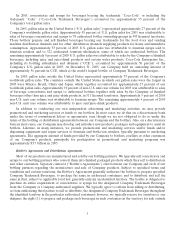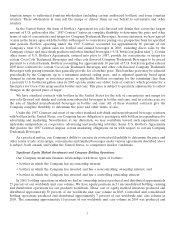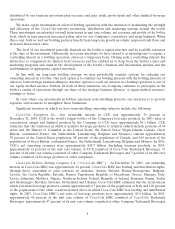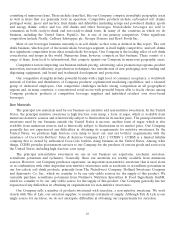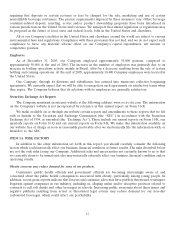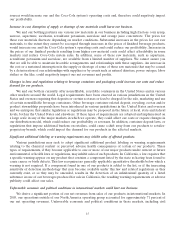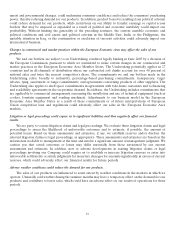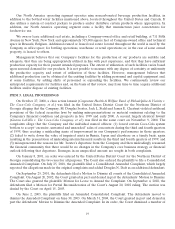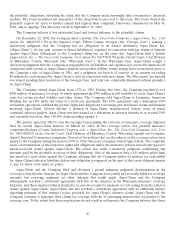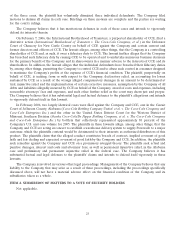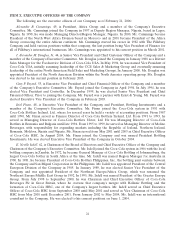Coca Cola 2005 Annual Report Download - page 17
Download and view the complete annual report
Please find page 17 of the 2005 Coca Cola annual report below. You can navigate through the pages in the report by either clicking on the pages listed below, or by using the keyword search tool below to find specific information within the annual report.sources would increase our and the Coca-Cola system’s operating costs and, therefore could negatively impact
our profitability.
Increase in cost, disruption of supply or shortage of raw materials could harm our business.
We and our bottling partners use various raw materials in our business including high fructose corn syrup,
sucrose, aspartame, saccharin, acesulfame potassium, sucralose and orange juice concentrate. The prices for
these raw materials fluctuate depending on market conditions. Substantial increases in the prices for our raw
materials, to the extent they cannot be recouped through increases in the prices of finished beverage products,
would increase our and the Coca-Cola system’s operating costs and could reduce our profitability. Increases in
the prices of our finished products resulting from higher raw material costs could affect affordability in some
markets and reduce Coca-Cola system sales. In addition, some of these raw materials, such as aspartame,
acesulfame potassium and sucralose, are available from a limited number of suppliers. We cannot assure you
that we will be able to maintain favorable arrangements and relationships with these suppliers. An increase in
the cost or a sustained interruption in the supply or shortage of some of these raw materials that may be caused
by a deterioration of our relationships with suppliers or by events such as natural disasters, power outages, labor
strikes or the like, could negatively impact our net revenues and profits.
Changes in laws and regulations relating to beverage containers and packaging could increase our costs and reduce
demand for our products.
We and our bottlers currently offer nonrefillable, recyclable containers in the United States and in various
other markets around the world. Legal requirements have been enacted in various jurisdictions in the United
States and overseas requiring that deposits or certain ecotaxes or fees be charged for the sale, marketing and use
of certain nonrefillable beverage containers. Other beverage container-related deposit, recycling, ecotax and/or
product stewardship proposals have been introduced in various jurisdictions in the United States and overseas
and we anticipate that similar legislation or regulations may be proposed in the future at local, state and federal
levels, both in the United States and elsewhere. If these types of requirements are adopted and implemented on
a large scale in any of the major markets in which we operate, they could affect our costs or require changes in
our distribution model, which could reduce our profitability or revenues. In addition, container-deposit laws, or
regulations that impose additional burdens on retailers, could cause a shift away from our products to retailer-
proprietary brands, which could impact the demand for our products in the affected markets.
Significant additional labeling or warning requirements may inhibit sales of affected products.
Various jurisdictions may seek to adopt significant additional product labeling or warning requirements
relating to the chemical content or perceived adverse health consequences of certain of our products. These
types of requirements, if they become applicable to one or more of our major products under current or future
environmental or health laws or regulations, may inhibit sales of such products. In California, a law requires that
a specific warning appear on any product that contains a component listed by the state as having been found to
cause cancer or birth defects. This law recognizes no generally applicable quantitative thresholds below which a
warning is not required. If a component found in one of our products is added to the list, or if the increasing
sensitivity of detection methodology that may become available under this law and related regulations as they
currently exist, or as they may be amended, results in the detection of an infinitesimal quantity of a listed
substance in one of our beverages produced for sale in California, the resulting warning requirements or adverse
publicity could affect our sales.
Unfavorable economic and political conditions in international markets could hurt our business.
We derive a significant portion of our net revenues from sales of our products in international markets. In
2005, our operations outside of our North America operating group accounted for approximately 71 percent of
our net operating revenues. Unfavorable economic and political conditions in these markets, including civil
15


